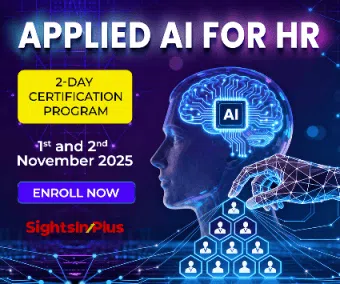In the new world, where employee experience is becoming cardinal to business success, Rewards & Recognition (R&R) have taken center stage in India Inc.’s people strategies.
Gone are the days when yearly appraisals or service anniversary plaques were enough to motivate talent. Today’s workforce seeks timely, meaningful, and personalized recognition that resonates with their values and contributions.
Now, the real question is,
Are we all prioritizing it?
Are we still considering R&R as a nice-to-have element?
Are we still considering that productivity can increase either by cost reduction or by headcount?
When we ask the right questions that reflect our preparedness, we begin to justify our position in shaping a relevant R&R program for the organization. Here is the catch — recognition and rewards cannot follow a “one size fits all” model; they cannot simply be copied and pasted from elsewhere.
There is a traditional perception that a reward is linked to performance and whatever the output given to the employee is their reward. This has changed over time and the evolution in people’s practices is now more revolutionary and futuristic.
Adoption is the Key
Emphasizing individual achievements and recognition drive, aiming for a peer-to-peer recognition model fosters a sense of belonging and inclusiveness.
While individual adoption plays a key role, organizations are also focusing on national and global recognition to enhance brand visibility and position themselves as Employers of Choice, aligned with their core values. Learning experience programs are increasingly being designed with gamification and rewards, fostering a culture of continuous learning and adaptability.
Making recognitions beyond monitory rewards, Personalized rewards—such as learning credits, wellness benefits, and even sabbaticals—are replacing generic gift cards.
Recognition is also expanding to highlight diverse contributions: innovation, collaboration, inclusivity, and social impact, not just revenue-driving results.
Tech Fusion to HR
Indian organizations, particularly in the tech, start-up, BFSI sectors and others, are embracing real-time, peer-to-peer recognition platforms. Tools like Empuls and Bonusly are becoming common in HR tech stacks, enabling instant applause and transparent reward systems.
Organizations are increasingly using AI to tailor rewards and recognition programs to individual preferences. Engaging via Gamification elements not only democratizes recognition but also aligns it closely with company values.
Measurement Anxiety
Despite progress, many organizations face a fundamental challenge in measuring the impact created by an R&R program.
- Lack of Metrics: Organizations that have implemented effective R&R programs are now struggling to define KPIs that depict the impact of R&R on Retention and Performance.
- Personal Bias: Peer nominations and manager-led recognition can sometimes be skewed, leading to perceived unfairness or favoritism risk, as subjectivity and personal bias.
- Digital Fatigue: Sometimes, overuse of tech platforms in managing a large people landscape results in a lack of emotional authenticity and results in a dip in adoption over the reduced perceived value over time.
- Multi-Cultural Integration: For multi-location or hybrid teams, ensuring consistent and culturally relevant recognition practices is an ongoing struggle.
- Direct Impact: Determining the direct impact of an R&R program on employee performance and organizational success might not be simply a data result. It has an impact over a period and shows in your Employee cultural attributes contributing largely to the overall success.
However, for the measurements, Organizations should have robust data analytics, people analytics to draw meaningful insights
The Rise & The Future
HR leaders are promoting culture-led recognition programs and embedding R&R in organizational DNA. India’s diverse cultural landscape means that a “one-size-fits-all” approach may not work.
There are more customized programs than the traditional ones to address diverse cultural needs. Organizations are embedding appreciation into daily routines, team rituals, and leadership behaviors to raise the bar. Using pulse surveys, feedback loops, and AI-powered sentiment analysis, measurement is moving beyond Frequency to Quality and Emotional Impact.
As the new Gen Zs and millennials enter the workforce with expectations for quick recognition, continuous feedback, and alignment with purpose, R&R will continue to evolve.
What remains timeless is the fundamental human need to feel seen, heard, and valued. As we adopt and adapt to the demands of the new age, one truth endures — it is the people who matter most, and it is the human touch that truly makes the difference.
R&R beyond Employees:
Reward & Recognition in Channel Loyalty Programs is a strategic scheme used by companies to motivate, engage, and retain their channel partners, such as distributors, retailers, dealers, agents, or resellers, by acknowledging their contribution and incentivizing their performance.
I considered myself lucky enough to study this part in one of my recent experiences. R&R is no longer an exclusive employee-centric flagship program. Beyond the employee’s program, it is also structurally followed as a Business partners’ engagement and motivation program.
It drives performance by motivating the business partners to sell more, stock faster-moving products, or promote new launches. It fosters long-term loyalty by recognizing and rewarding efforts, building emotional attachment to the brand. There are monetary, non-monetary, and experiential reward programs for sustainable channel loyalty programs run on various digital platforms, developed to give a gamified experience to the users.
Reward & recognition in channel loyalty programs is not just about incentives, it’s about creating a relationship of mutual growth and sustained motivation.
My Submission:
I discovered the evolving role of Rewards & Recognition (R&R) in shaping modern organizational culture and performance in India. It also highlights how R&R is being effectively used beyond employees, especially in channel loyalty programs, to engage and retain business partners in a way that benefits both sides.
The narrative shifts from traditional practices to the contemporary, personalized, and tech-enabled frameworks that are now essential to users’ experience and brand building.
In a world where employee expectations, digital transformation, and cultural dynamics are rapidly changing, this submission brings forth practical insights, risks, and the future-forward view of how R&R must evolve—not just in form, but in intent and impact.
Note: We are also on WhatsApp, LinkedIn, Google News, and YouTube, to get the latest news updates. Subscribe to our Channels. WhatsApp– Click Here, Google News– Click Here, YouTube – Click Here, and LinkedIn– Click Here.



